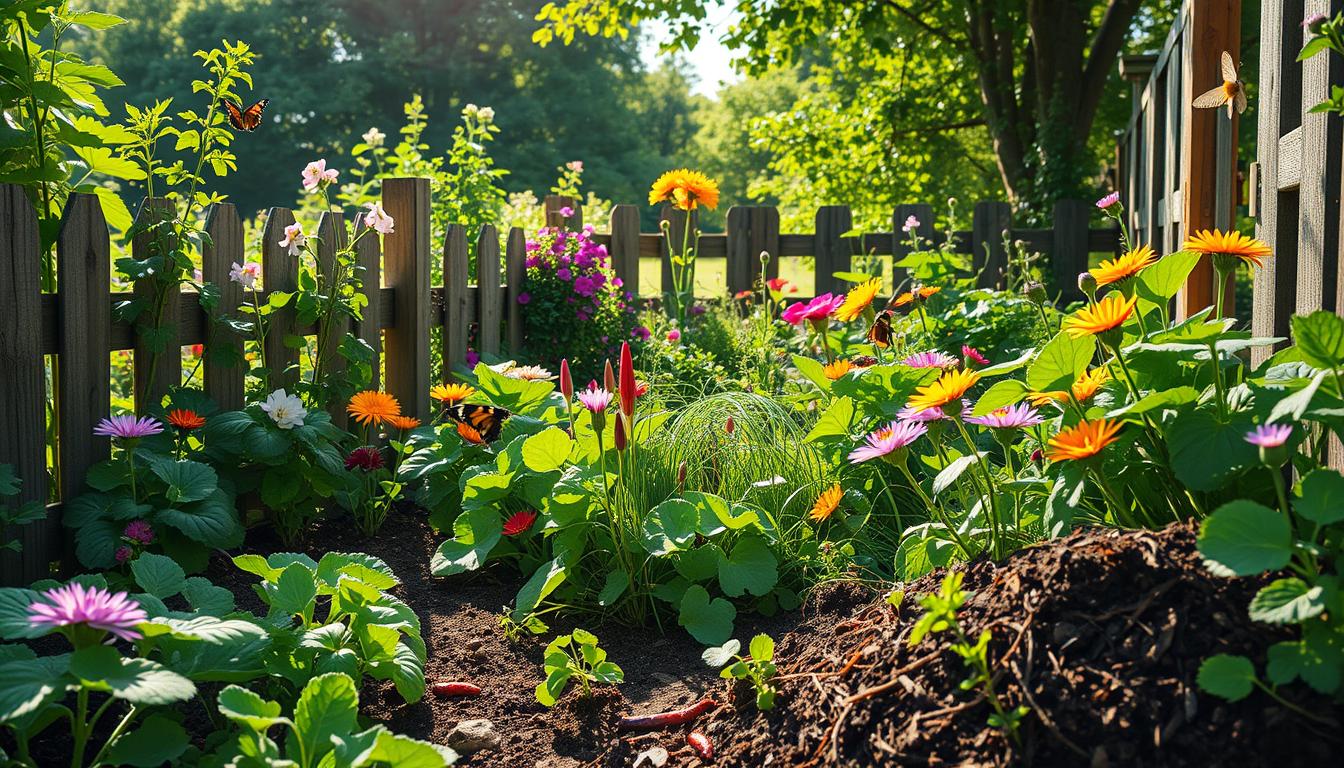Welcome to my guide on creating a thriving garden without harsh chemicals. I’m excited to share my knowledge on chemical-free gardening. It’s better for the environment and healthier for you and your family. Organic gardening is a great starting point, and I’ll give you tips and tricks to get started.
Chemical-free gardening is simple and effective for a beautiful, sustainable garden. By using organic gardening methods, you make your garden healthier and more eco-friendly. In this guide, I’ll cover everything you need to know for a stunning garden using chemical-free techniques.
I’ll share my knowledge on planning your garden layout, choosing the right plants, and maintaining your garden organically. Whether you’re new or experienced, my guide will give you the tools and expertise to succeed. Let’s start this journey to a beautiful, sustainable garden with chemical-free gardening techniques.
Understanding Chemical-Free Gardening
Gardening is more than just growing plants. It’s about creating a safe space for everyone. Non-toxic gardening keeps my garden free from harmful chemicals. It makes my garden a peaceful place for all to enjoy.
Natural gardening works with nature to create a balanced ecosystem. It promotes biodiversity and cuts down on synthetic fertilizers and pesticides.
Chemical-free gardening makes my soil healthier. It also brings more plants and animals to my garden. Plus, it helps reduce my carbon footprint.
- Improved soil health through natural fertilizers and composting
- Increased biodiversity by welcoming beneficial insects and animals
- Reduced carbon footprint by using fewer synthetic chemicals and fertilizers
Chemical-free gardening is about harmony with nature. It’s about creating a thriving ecosystem. By choosing natural gardening, I make a sustainable garden that benefits me and the environment. 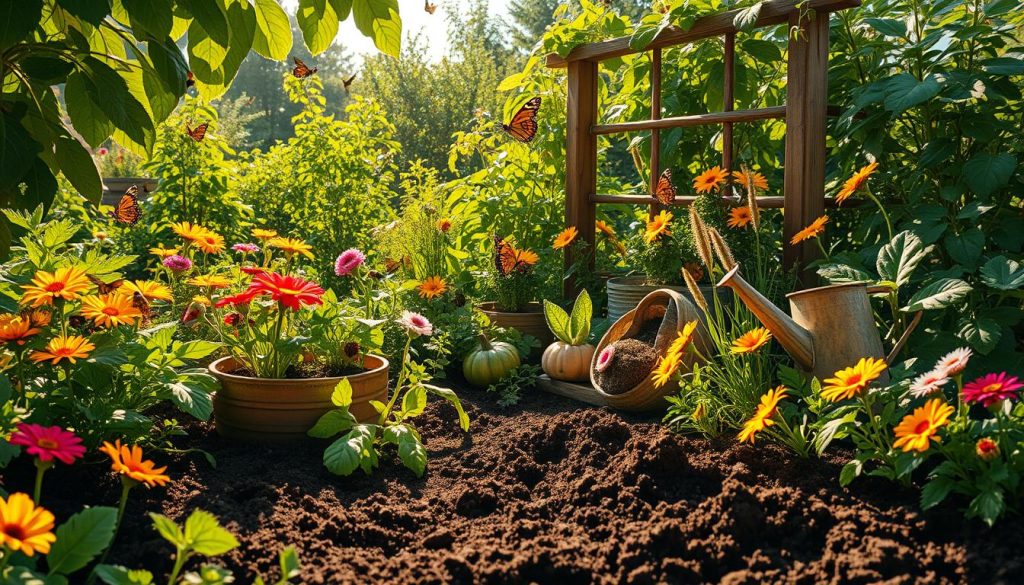
Learning about non-toxic gardening and natural practices is key. Simple changes in my gardening routine make my garden healthier and sustainable. It brings joy and beauty to my life.
Getting Started with Organic Practices
To start your eco-friendly gardening journey, it’s key to learn the basics. This method aims to make your garden and the environment work together. By using eco-friendly gardening, you’ll cut down on carbon emissions and grow a vibrant, healthy garden.
When designing your garden, think about how much sunlight and water each plant needs. This helps pick the best plants for your area and soil. Using compost, collecting rainwater, and rotating crops are all part of sustainable gardening. These steps help keep your garden’s ecosystem balanced.
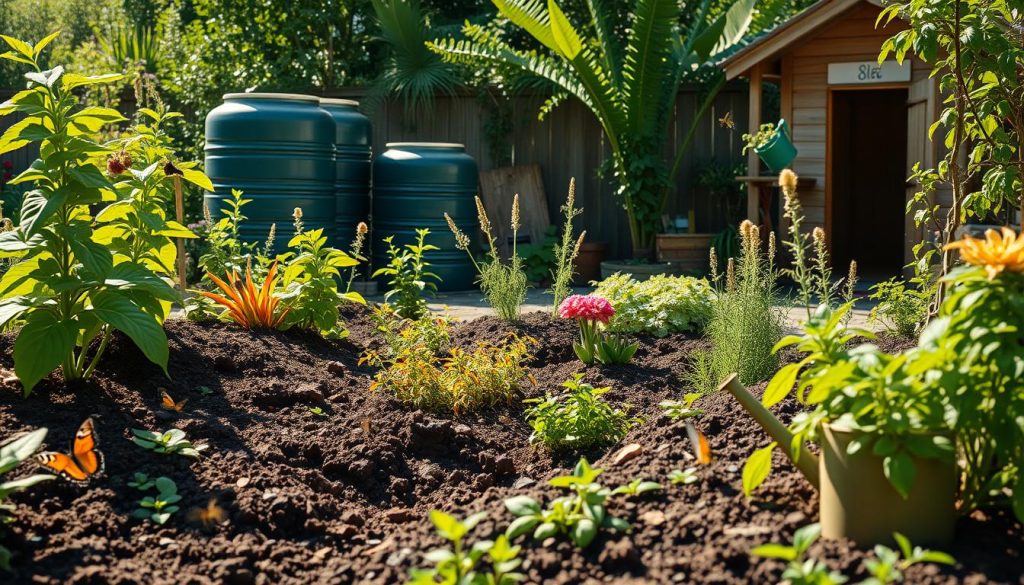
- Use natural fertilizers like compost or manure to enrich your soil
- Implement rainwater harvesting to reduce water waste
- Choose plants that are native to your region to minimize the need for pesticides and fertilizers
By following these eco-friendly gardening tips, you’re on the path to a sustainable garden. Sustainable gardening is about working with nature to make a beautiful, healthy outdoor space.
| Practice | Benefits |
|---|---|
| Composting | Reduces waste, creates natural fertilizer |
| Rainwater Harvesting | Conserves water, reduces stormwater runoff |
| Crop Rotation | Improves soil health, reduces pest and disease buildup |
Soil Health: The Foundation of My Garden
Exploring pesticide-free gardening, I’ve learned that soil health is key. Green gardening lets beneficial microorganisms thrive. They break down organic matter and feed my plants.
I’ve started composting to boost soil health. Compost adds microorganisms that break down organic matter. This reduces the need for harmful fertilizers and pesticides.
Importance of Healthy Soil
Healthy soil is full of life, from bacteria to fungi. It’s vital for plant growth. It helps with water, prevents erosion, and supports a diverse ecosystem.
By choosing pesticide-free gardening, I keep my soil healthy. This is crucial for my garden’s overall health.
Composting: A Simple Guide
Composting is easy. It mixes organic materials like food scraps and yard waste. Letting them decompose creates a nutrient-rich soil amendment.
By composting, I reduce waste and create a natural fertilizer. It promotes healthy soil and supports biodiversity.
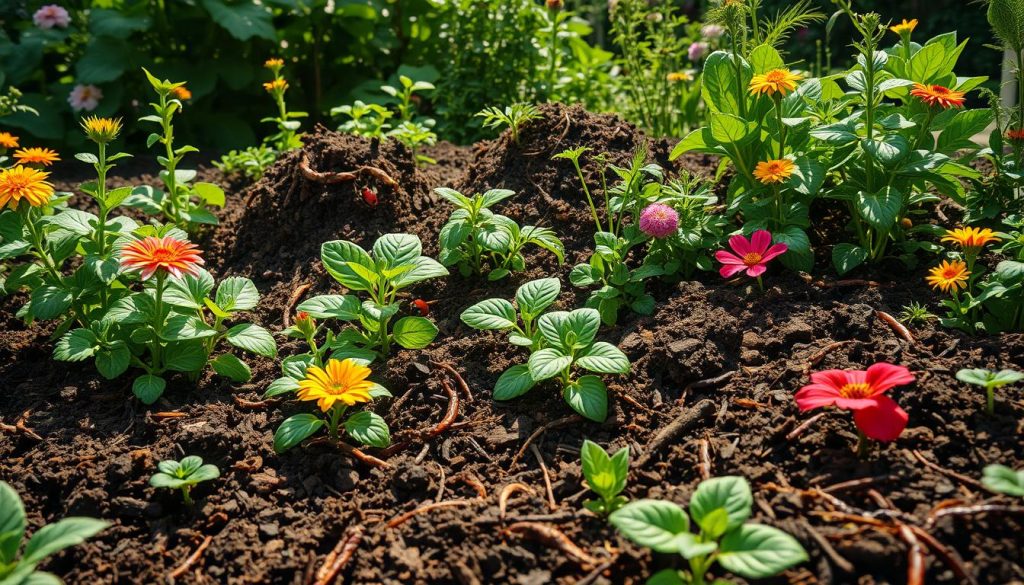
- Reduced waste
- Natural fertilizer
- Promotes healthy soil
- Supports biodiversity
Embracing pesticide-free gardening and green practices creates a thriving ecosystem. It supports a wide range of plant and animal life.
| Composting Materials | Benefits |
|---|---|
| Food scraps | Rich in nutrients |
| Yard waste | High in carbon |
| Manure | Rich in microorganisms |
Natural Pest Control Techniques
In chemical-free gardening, it’s key to manage pests without harsh chemicals. Organic gardening works with nature to keep things balanced. By attracting good insects like bees and butterflies, your garden stays healthy. Natural pest repellents, like neem oil and garlic spray, help keep pests away.
Some main benefits of natural pest control include:
- Less harm to the environment
- Healthier soil
- More biodiversity
To start with natural pest control, try making your own DIY repellents. Here’s a simple recipe:
| Ingredient | Quantity |
|---|---|
| Neem oil | 2 tablespoons |
| Garlic oil | 1 tablespoon |
| Water | 1 quart |
Mix these ingredients and spray them on your plants to repel pests. Always test a small area first. By using these methods, you can grow a healthy and sustainable garden.
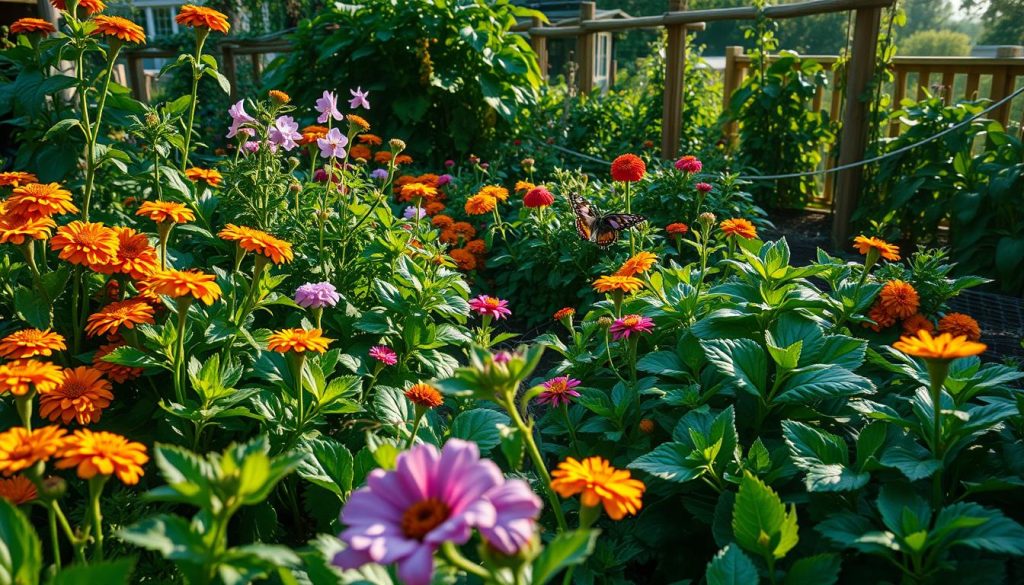
Watering Wisely without Chemicals
As I explore non-toxic gardening, I’ve learned the value of smart watering. Natural gardening means working with nature’s rhythms. Using natural mulching is a key technique to save water.
It keeps moisture in the soil, helping plants grow strong. This method also cuts down on evaporation.
In non-toxic gardening, picking the right mulch is crucial. Options like wood chips, bark, and leaves are great. They keep the soil cool, stop weeds, and hold moisture.
By adding mulch around my plants, I water less often. This is vital during the hot summer months.
- Choose the right type of mulch for your plants and climate
- Apply a thick enough layer to retain moisture and suppress weeds
- Keep the mulch a few inches away from plant stems to prevent rot and disease
By using these tips and natural mulching, I make my garden healthier. It becomes a sustainable space that works with nature.
Fertilizing the Natural Way
Eco-friendly gardening is about making a balanced and sustainable ecosystem. I’m excited to share my knowledge on natural fertilizers with you. Sustainable gardening is more than a trend; it’s a lifestyle that helps our planet and health. Using organic fertilizers helps us reduce waste and use resources better, creating a closed-loop system.
In eco-friendly gardening, fertilizing is key for healthy plant growth. I’ve found compost and manure tea to be great for my plants. These natural fertilizers are effective and easy to make at home. By choosing sustainable gardening, we can cut down on synthetic fertilizers and make our gardens more eco-friendly.
Understanding Organic Fertilizers
Organic fertilizers come from natural sources like plants, animals, and minerals. They give nutrients slowly, feeding my plants steadily. Examples include fish emulsion, bone meal, and alfalfa meal. These fertilizers are full of nutrients and can be mixed to create a balanced blend.
Homemade Fertilizer Recipes
Making your own fertilizer at home is simple. Here are a few easy recipes to start with:
- Compost tea: Steep a bucket of compost in water for a nutrient-rich liquid fertilizer.
- Manure tea: Like compost tea, but made with animal manure.
- Worm casting tea: Use worm castings to make a fertilizer high in nutrients.
Using these homemade fertilizer recipes helps create a sustainable gardening system. It’s good for the environment and your plants. Remember, eco-friendly gardening aims to create a balanced ecosystem, and fertilizing is a crucial step.
Seasonal Gardening Tips
Understanding the changing seasons is key for a thriving garden. By using green gardening practices, I’ve created a balanced ecosystem. This supports many plants and beneficial insects.
What to Plant in Each Season
Choosing the right plants for each season is crucial. Here’s a quick guide on what to plant:
| Season | Plants to Plant |
|---|---|
| Spring | Tomatoes, peppers, cucumbers, and carrots |
| Summer | Zucchini, eggplant, okra, and herbs like basil and mint |
| Fall | Broccoli, kale, spinach, and root vegetables like beets and radishes |
| Winter | Brussels sprouts, cabbage, and lettuce, as well as cover crops like clover and rye |
Rotating Crops for Healthy Soil
Rotating crops keeps the soil healthy in a pesticide-free garden. Changing plants in each bed avoids nutrient depletion. It also reduces pests and diseases. This method boosts biodiversity and soil fertility.
Maintaining a Chemical-Free Garden
To keep your garden healthy, regular care is key. Chemical-free gardening aims to create a balanced ecosystem. This balance is achieved by watching your garden for signs of stress. As a gardener, I’ve found that organic gardening is vital for a garden’s health.
Common signs of garden stress include pests, diseases, and nutrient shortages. To tackle these issues naturally, knowing chemical-free gardening techniques is crucial. This includes using natural pest control and organic fertilizers like compost or homemade recipes.
Regular Maintenance Routines
A well-kept garden needs regular watering, mulching, and pruning. Here are some tips to help your garden stay healthy:
- Water your plants deeply but infrequently to encourage deep root growth
- Mulch around your plants to retain moisture and suppress weeds
- Prune your plants regularly to promote healthy growth and prevent disease
Signs of Garden Stress
Knowing the signs of garden stress is important for a healthy garden. Some common signs include:
- Yellowing or browning leaves
- Holes or tears in leaves
- Wilting or droopy plants
By following these tips and watching for garden stress signs, you can keep your garden thriving. Enjoy the benefits of organic gardening.
Navigating Weeds Naturally
As I explore non-toxic gardening, I’ve learned the value of fighting weeds naturally. This method keeps my garden healthy and balanced. It’s about working with nature, not against it. By using mulching and companion planting, I’ve kept weeds out of my garden.
Combining physical barriers with natural methods is key. I use organic mulch to stop weeds and plant species that repel them. This saves me time on weeding, letting me enjoy gardening more.
Strategies for Weed Prevention
- Mulching: Applying a thick layer of organic mulch to suppress weed growth
- Companion planting: Planting certain species that repel weeds or attract beneficial insects
- Crop rotation: Rotating crops to break the life cycle of weeds and reduce the risk of disease
Hand-weeding is also effective for me. It lets me get close to my plants and remove weeds early. This keeps my garden healthy and lets me connect with nature.
Hand-Weeding Techniques
When hand-weeding, I’m careful not to harm my plants. I use tools like a hoe and hand fork to remove weeds. These natural methods help me maintain a balanced garden with little upkeep.
Choosing Eco-Friendly Tools and Supplies
As I explore eco-friendly gardening, I’ve learned the value of the right tools and supplies. Sustainable gardening aims to use resources wisely and reduce waste. This method keeps our gardens healthy and our planet safe.
Choosing the right tools and supplies is key in eco-friendly gardening. I prefer tools made from bamboo, recycled metals, and wood that’s good for the planet. These tools last long and are better for the environment. For example, I use bamboo trowels, rakes from recycled materials, and watering cans from sustainable wood.
Sustainable Gardening Tools
- Bamboo-handled trowels
- Rakes made from recycled materials
- Watering cans crafted from sustainable wood
I also pick organic seeds for my garden. These seeds are GMO-free and don’t have pesticides. Using organic seeds helps my soil, increases my harvest, and is better for the planet.
Organic Seeds and Their Benefits
Using eco-friendly tools and supplies helps me garden in a way that’s good for the earth. Whether you’re new to gardening or have been doing it for years, using these tools can help a lot. So, why not try it and join the sustainable gardening movement?
Resources and Community Support
Keeping a pesticide-free garden is rewarding. It’s even better with a supportive community. Local resources and events can teach you new things. They help you solve problems and stay excited about gardening without chemicals.
Explore Gardening Books and Websites
Start by reading books on pesticide-free gardening. They cover topics like healthy soil and natural pest control. Websites also offer tips, tutorials, and forums to connect with others.
Join Local Gardening Groups and Events
Look for local gardening clubs, community gardens, or horticultural societies. They host workshops, plant swaps, and social events. These are great for sharing knowledge, swapping plants, and finding inspiration.
Using available resources and community support helps you succeed in gardening without chemicals. Together, we can create beautiful, sustainable gardens. These gardens nourish the land and improve our well-being.

